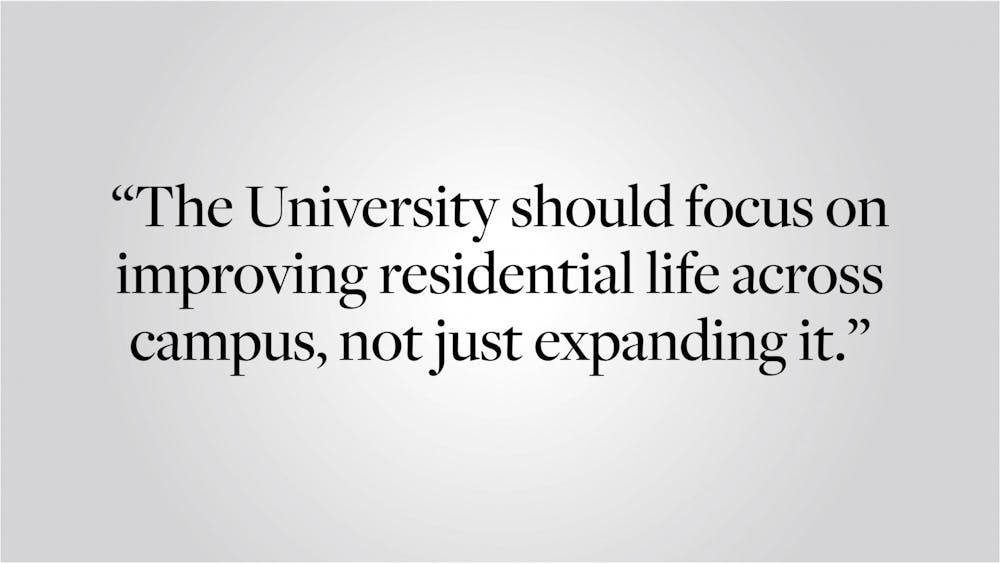For the first time since New Dorm opened in 1991, Brown’s campus has a new residence hall: the Wellness Center and Residence Hall, housing both a 162-bed dormitory and the University’s health services. The new building opened its doors to students on May 9 this year. Featuring air conditioning, floor-to-ceiling windows and a combination of singles and four-person suites, the residence hall seems nearly too good to be true. Those who moved in over the summer have voiced their appreciation for its design and amenities, as well as its goal of integrating wellness with student life.
The Wellness Center dorm certainly sets a promising tone for future expansions of University housing, and its mission of promoting well-being is admirable. At the same time, the building’s almost luxurious design highlights existing inequities in the Brown residential experience, setting a worrying precedent for future development. What we want is for there to be no “better” dorms — only good ones.
Because students are required to live on campus through their sixth semester, nearly three-quarters of the undergraduate student body lives in on-campus housing. After their first year, most students end up taking part in the Housing Lottery, a process that randomly assigns selection times at which students can choose any unclaimed room. This random lottery system is likely the fairest way to divvy up available housing; what isn’t fair is the staggering disparity between residence halls.
While some students thrive in the suites of Barbour Hall and 315 Thayer St., complete with kitchens and furnished living rooms, others are isolated in the cramped singles of Grad Center. Some live in spacious doubles with high ceilings, like in Metcalf and Miller; others in forced basement triples. Those lucky enough to live in Wellness Center or New Dorm enjoy the rare luxury of air conditioning, while the rest sweat out the summer heat. New and renovated dorms boast bright, clean halls and inviting common areas. Others show their age in peeling paint and dingy carpets.
These details may seem small, but they have an outsized impact on student social and emotional wellbeing. Brown purports to have a campus that “instills a sense of community among our members,” according to its Strategic Plan for Campus Development. But the drastic inequalities in housing end up fracturing us instead. What’s also worth noting about the Wellness dorm is that it requires an application, selecting for students with wellness-oriented “gifts and practices.” But don’t all students, regardless of what they have to offer, deserve good housing? Instead of fostering community, this selection process only weakens it.
The University charges each student roughly $10,000 per year to live on campus, without factoring in financial aid. As each semester lasts about four months, this room fee works out to a hefty rent of $1,250 per month. Room fees are identical regardless of where a student lives on campus — whether they live in the Wellness Center or in Grad Center. This is not to say that we shouldn’t all pay the same rent. But equal rent should mean equal living conditions, and that just isn’t the case.
So why is there so much variation among housing options? Perhaps for the same reason that New Dorm has kept its name for so long: the University didn’t build a new residence hall for three decades. Additionally, although several large-scale renovations took place in that time period, the most recent was completed in 2013, when first-year residence halls Metcalf and Miller were overhauled. Smaller, piecemeal improvements have been made since then, but actual progress toward better and fairer housing has slowed considerably.
The Wellness Center dorm, in addition to the planned Brook Street residence hall, might seem like steps in the right direction. But we’re skeptical that the University will maintain that momentum. Its principal concern seems to be increasing housing capacity, not improving quality overall; administrators have suggested that “by constructing these two new facilities, the University hopes to eliminate the need for off-campus housing for undergraduates,” The Herald previously reported. In the same article, Koren Bakkegard, associate vice president for campus life, noted that housing more students on campus would alleviate pressure on the Providence housing market. That goal is commendable. But ultimately, adding just these two residence halls, no matter how nice they are, will materially improve the lives of only a fraction of students on campus. The Wellness Center has 162 beds. So why is the University prioritizing the wellness of just 162 students?
To be clear, we aren’t advocating for luxury; we don’t need to live in a five-star hotel. And we hold nothing against the students who live in the Wellness Center, or any of the “better” dorms. What we want is equity.
To that end, the University should focus on improving residential life across campus, not just expanding it. Whether that means replacing old residence halls with new ones or renovating the ones we have, the University should not stop at the Wellness Center, and it shouldn’t wait 30 more years. It should continue to improve conditions until all its students can live well.
—Editorials are written by The Herald’s editorial page board. This editorial was written by its editor Johnny Ren ’23, and members Clara Gutman Argemí ’22, Catherine Healy ’22, Olivia Burdette ’22, Devan Paul ’24 and Kate Waisel ’24.





